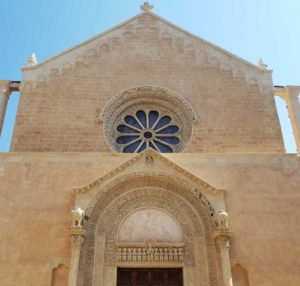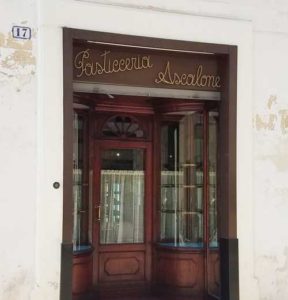Things to see and do in Galatina
Galatina is a town in Salento that has all the baroque charm of well-known and popular Lecce scaled down and definitely less crowded. A trip to Galatina is a great alternative to Lecce if you are looking to avoid high-season crowds and still get to enjoy the baroque beauty of Salento. Galatina may live in the shadow of Lecce, as far as architecture and sights are concerned. But rest assured that there are a lot of things to see and do in Galatina. It’s a jewel box that stands on its own… and has at least a few treasures that even Lecce would be jealous of.
As with all of these lovely baroque towns, the beauty is everywhere and a walk through the city is quite an experience all by itself. As you walk, remind yourself periodically to look up. There is almost always something interesting to see. Walking past a tire shop on your way from the train station? Look up and see the ornate corbels lined up above the big garage door. These details – the impossibly ornate baroque architecture paired with the modern, everyday repair shops and offices – will make you smile. And they are everywhere, side by side with opulent palazzos and churches… as well as the bakery that created the legendary pasticciotto.
My strategy in most places is to wade right in and just walk around. Galatina is perfect for this, since it’s fairly small and you can simply soak up the beauty as you stroll around. That said, it can help to have a destination or two in mind so you can decide which direction to start walking. In a small city that boasts dozens of churches, you have plenty of art and architecture to keep you busy. But these are the headliners:

Basilica of St. Catherine D’Alessandria – The facade of the basilica is a romanesque work of art itself, with its rose window and three portals decorated in intricately carved stone. This is just the beginning, though. The church is an overstuffed jewel box of frescoes. It can be downright overwhelming.
Chiesa Madre dei Santi Pietro e Paolo – Church of Sts. Peter and Paul – Late baroque church carved in Lecce stone facing the main piazza. The statuary on the front is curiously more focused on the Virgin Mary and only secondarily on the namesakes of the church (the apostles Peter and Paul). The interior is overflowing with opulent marble decoration and frescoes.
Piazza Alighieri – If you’re frescoed-out and have gone blind to all the art, a break is called for. Go to the public garden for a bit of greenery. Admire “La Pupa,” the fountain statue on the south end of the piazza. Stop and grab a caffè leccese at Bar delle Rose, the cafe in the park, or head to…
Pasticceria Andrea Ascalone – For a chance to try the legendary pasticciotto from the bakery that invented it.The aromas of the delightful things inside will hit you before you even step through the door. It’s a really delightful, multisensory experience. The sweet smells wafting from the bakery in back, the rich wood and marble decor, and (of course) the taste of the iconic pastry itself. Step inside and soak it all in.

I didn’t see any point in restraint, so I bought two just for myself and had them elegantly wrapped up per portare via (to go). The couple ahead of me walked out with six. It’s possible that they were bringing them as a hostess gift somewhere, but I wouldn’t be surprised if they weren’t planning to share them at all.
The three principle porte (doorways) – The main entrances through the original city walls. Originally, there were five, but three remain: Porta Luce, Porta San Pietro, and Porta Cappuccini.
Torre dell’orologio – (clocktower) – A picturesque clocktower built in 1861 and dedicated to Vittorio Emanuele II. Admire the architecture — the clock mechanisms are original. It’s a lovely place to pause your stroll through town.
Palazzo Bardoscia-Lubelli-Spoti – One of the most magnificent facades I have seen on a secular building in the Salento. Churches and government buildings tend to be ornate, but this is a privately owned historic palace. Beautifully sculpted Lecce stone, like you see everywhere in the region… but what is especially striking are the aqua-colored shutters on the second level. It was built in 1772 during the years when towns like Galatina were for the Bardoscia family, and is now owned by the Spoti family. Blah blah history blah… it’s beautiful. That’s the moral to this story.
If you like drawing, I highly recommend bringing your sketchbook here and immersing yourself in the details.
Getting to Galatina from Lecce
I went (predictably) by train. It was about five euro to and from Lecce and around 40 minutes each way. No need to change trains even. Although, when I went, we did have to change trains on the way back for… reasons. I didn’t ask, I just followed directions as we all filed off one train and onto another. I’d recommend this (taking the train, not the following directions bit… well, I mean that too). If you’re pressed for time, are in a group, or want to check out other places nearby, it might be better to drive.
Events
June 28 – 29 – feast day of Sts. Peter and Paul – patron saints of Galatina. The days surrounding these are filled with festivities, music and dancing — in particular the pizzica, a lively, local folk dance.
What to learn more?
The official website of Galatina (in Italian, but worth clicking through even if you don’t know the language) where you can find more things to see and do in Galatina.
